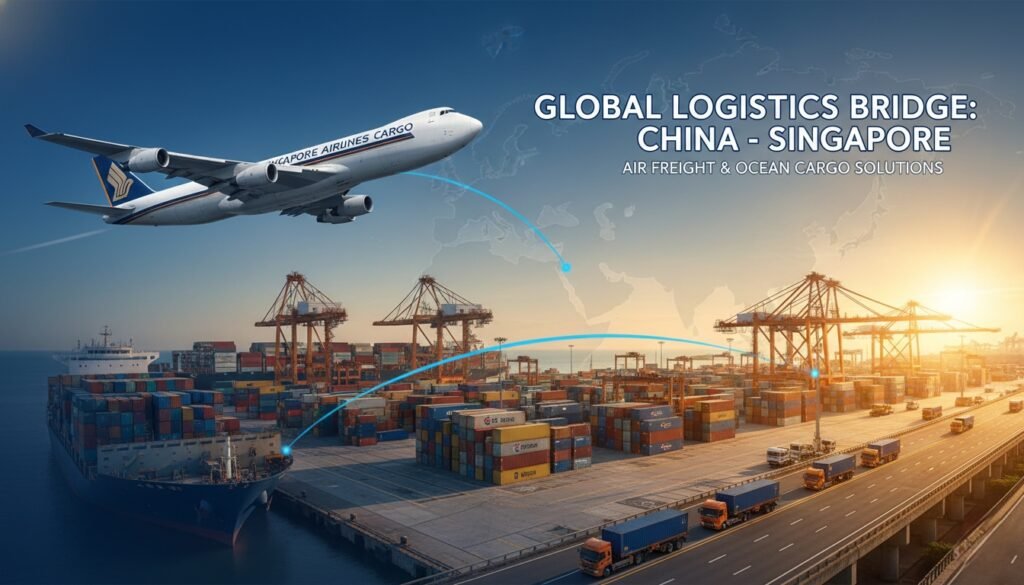Guide to Shipping via Singapore Airlines from China to Singapore
By Guanwutong / November 13, 2025
In the complex landscape of international trade between China and Southeast Asia, “speed” is often a relative term. For some shippers, a 3-day transit is sufficient; for others, a delay of a few hours can impact the entire supply chain.
While Singapore Airlines (SQ) is a primary choice for air cargo connectivity, efficient logistics requires more than just booking a flight.
This article analyzes the air freight process from operational, market, and service strategy perspectives, providing practical insights for B2B exporters and importers looking to optimize their China-to-Singapore supply chain.

1. Overview of Singapore Airlines Cargo Services
Singapore Airlines (SQ) is widely recognized as one of the major carriers connecting China and Singapore. With a network covering key gateways such as Shanghai (PVG), Beijing (PEK), Guangzhou (CAN), and Shenzhen (SZX), it offers high-frequency direct flight advantages, subject to specific seasonal flight schedules.
However, freight efficiency depends on comprehensive management before takeoff and after landing. This includes critical steps such as pickup, export declarations, warehousing, and final distribution. At GWT Shipping, we focus on optimizing these flows to ensure that the advantages of air transport are not lost due to ground delays.
2. Market Intelligence: Capacity and Trends
To make informed logistics decisions, it is essential to understand the current state of the China-Singapore air route.
The Capacity Landscape
While sea freight options (such as fast boats via OOCL/EMC) offer competitive transit times of approximately 3–4 days, air freight remains the standard solution for goods that are sensitive to time, temperature, or security controls.
This typically includes high-precision components, medical supplies, or urgent inventory replenishment.
Seasonality and Rate Volatility
Historical data suggests that air freight rates and capacity fluctuate based on market demand:
Q4 Peak (October – December): Driven by year-end manufacturing and e-commerce events, cargo space often tightens. Historical experience indicates that rates can fluctuate during this period.
Pre-Holiday Periods: In the weeks leading up to Chinese New Year, factory output typically surges.
Strategic Planning: During these high-demand periods, utilizing Block Space Agreements (BSA) or pre-booking can help reduce the risk of cargo being “offloaded” (delayed) due to capacity constraints.

3. Comparative Analysis (Reference Data)
The following table provides a general comparison between Singapore Airlines and other transport options to assist in decision-making.
Note: Data below is based on historical averages and is for reference only. Actual times may vary.
| Feature | Singapore Airlines (SQ) | Air China / China Eastern (CA/MU) | Indirect Carriers (via HK/BKK) |
| Transit Time (Airport-to-Airport) | Approx. 4-6 Hours (Direct) | Approx. 5-7 Hours (Direct) | Approx. 12-24 Hours (Transshipment) |
| Flight Frequency | High (Subject to schedule) | Medium | High (Requires connecting) |
| Reliability (Historical) | High | Medium | Varies by Hub Congestion |
| Ground Handling (Singapore) | Dedicated Terminals | Standard | Standard |
| Suitability | Urgent / Sensitive / Perishable | General Cargo | Cost-sensitive / Flexible time |
4. Customized Logistics Solutions
Many forwarders operate on a standard booking basis. At GWT Shipping, we provide customized solutions, proposing suitable transport modes based on cargo volume, urgency, and budget.
A. Optimization for Small Volumes (The “Under 200KG” Strategy)
Improper mode selection for small shipments can increase per-unit logistics costs.
Express vs. Air Freight: Historical data suggests that for shipments under approximately 150kg, courier services (DHL/UPS/FedEx) may offer a more competitive “all-in” rate compared to general air freight, which includes minimum fixed charges.
Consolidation: For shipments ranging from 150kg to 500kg, we can arrange air consolidation services. By pooling cargo, shippers can often access better weight-break rates.
B. The “Fast Sea Freight” Alternative
Not all shipments require air transport.
Time vs. Cost: Carriers like OOCL and EMC offer “Fast Boat” services from Shenzhen/Shekou to Singapore with a transit time of approximately 3–4 days.
Cost Efficiency: For non-urgent bulk restocking, this option can offer significant cost savings compared to air freight.
C. FCL Security (>15 CBM)
For volumes exceeding approximately 15 CBM, we typically recommend Full Container Load (FCL).
Advantage: FCL minimizes the risk of mixing with other importers’ cargo, potentially lowering insurance costs and enhancing security from the factory in China to the warehouse in Singapore.
D. Expedited Handling Options (HDS)
For time-critical shipments, we offer expedited handling options, often referred to as HDS (Hot Delivery Service).
Process: This service coordinates with ground terminals to prioritize cargo retrieval upon landing.
Benefit: It is designed to shorten the timeline between flight arrival and final delivery. If you have urgent cargo requirements, please contact us for specific service details.

5. Industry-Specific Handling Strategies
Different industries require different logistics approaches. We provide tailored services such as temperature control, batch shipping, and tracking based on cargo characteristics.
Electronics & Precision Goods: We offer solutions involving shock-watch labels and milestone tracking to monitor cargo integrity.
Retail & Fashion: We can assist with “Daily Replenishment” strategies, utilizing frequent flights to ship smaller batches, helping to manage inventory levels.
Perishables: For goods requiring temperature control, we facilitate pre-arrival customs declarations to ensure swift transfer to cold storage facilities upon release.
For any questions, feel free to contact GWT Shipping. Our team will provide professional, standards-compliant advice tailored to your specific needs.
6. Navigating Singapore Customs & TradeNet
Efficient customs clearance is critical to the speed of air freight. Singapore’s customs regulations are strict and digitized.
TradeNet System: As your declaring agent, GWT is registered to process import permits via the TradeNet system on behalf of importers.
GST Handling: As of 2024, the GST rate in Singapore is 9%. We assist clients in calculating the correct tax based on CIF value and can arrange DDP(관세 선납 운송) services to streamline the payment process.
Strategic Goods: For controlled items (such as dual-use technology), we assist in applying for necessary documents like the Import Certificate and Delivery Verification (ICDV).
7. Step-by-Step Shipping Process (Reference Timeline)
The following outlines the typical flow for an air shipment from China to Singapore via SQ.
Step 1: Booking & Preparation Based on cargo readiness, space is booked. It is recommended to confirm bookings 1-2 days in advance.
Step 2: Pickup & Warehouse Entry Goods are collected and brought to the export warehouse for weighing and labeling.
Step 3: Export Customs (China) Once documents are submitted, export clearance is typically completed within 2–4 hours, assuming all paperwork is correct.
Step 4: Flight Departure Cargo is loaded onto the scheduled Singapore Airlines flight.
Step 5: Import Clearance (Singapore) Permits are declared via TradeNet. Digital clearance usually allows for rapid release upon flight arrival.
Step 6: Final Delivery Depending on the service level selected, delivery to the final destination is typically arranged within 24 hours of clearance.
Conclusion
In the fast-paced trade corridor between China and Singapore, the choice of transport defines your supply chain efficiency. While Singapore Airlines (SQ) offers the necessary speed for high-stakes shipments, true reliability comes from how that shipment is managed on the ground.
At GWT Shipping, we bridge the gap between carrier capacity and operational reality. Whether you require the rapid connectivity of an SQ flight for urgent electronics, the precision of our TradeNet customs clearance, or the strategic cost-savings of our Fast Boat alternative, we ensure your logistics strategy is aligned with your business goals. We don’t just move cargo; we optimize your time and budget.
FAQ
Yes, we typically offer DDP (Delivered Duty Paid) services, where we can arrange the payment of the 9% GST on your behalf to facilitate smooth clearance.
We can assist by providing export agency services (often called “Maidan”) to help suppliers without their own licenses export compliant goods.
While rates vary by market, “Fast Boat” services (approx. 4 days transit) can offer significant savings compared to air freight. It is a viable option if the schedule allows for a few extra days.
Yes, we provide warehousing, sorting, and distribution services in Singapore for clients needing local logistics support.
Typically, a Commercial Invoice, Packing List, and Sales Contract are required. For certain goods, additional permits or certificates (like a Certificate of Origin) may be needed.
Yes, shipments via Singapore Airlines can be tracked using the Master Air Waybill (MAWB) number. We also provide status updates throughout the process.
Lithium batteries are classified as dangerous goods. They typically require a UN38.3 test report and a DGM appraisal. We can assist in arranging these for compliant transport.
Air freight is calculated on the higher of actual weight or volumetric weight. The standard volumetric ratio is 1:167 (1 CBM = 167 KG).
Ready to explore your shipping options?

